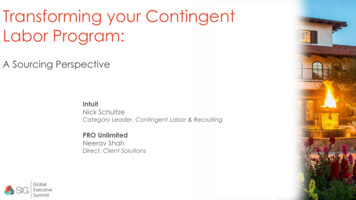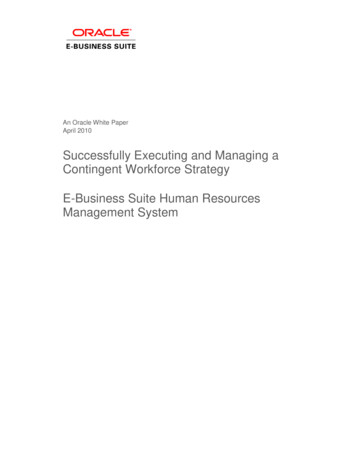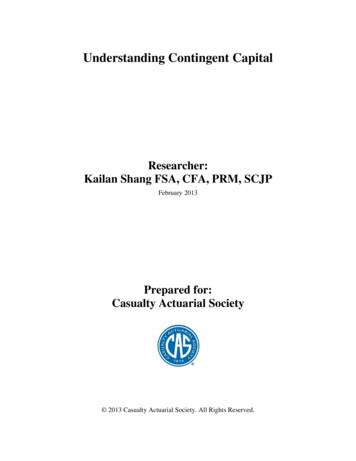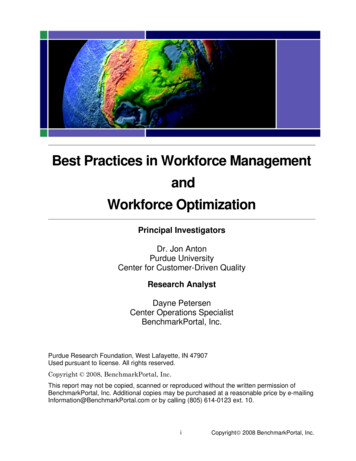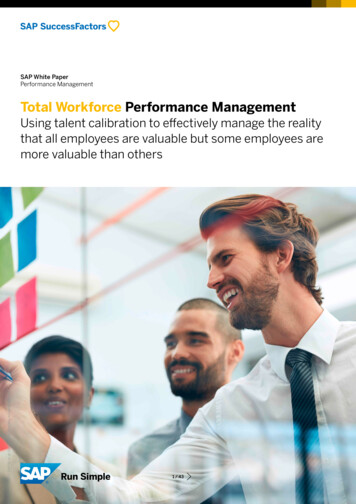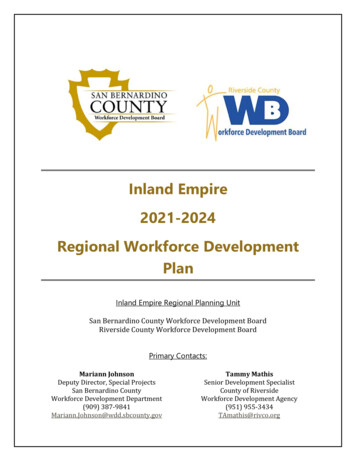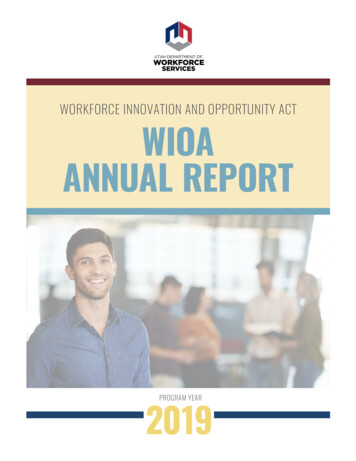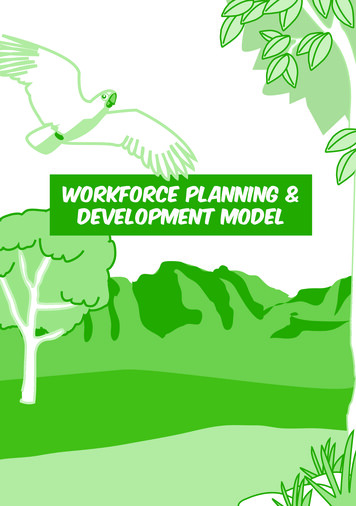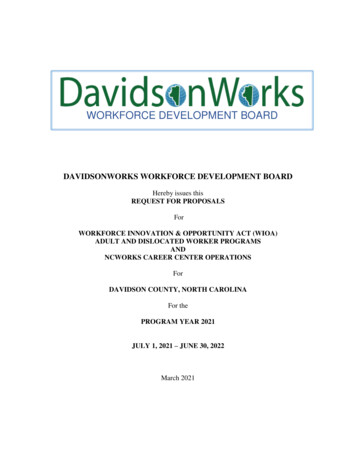
Transcription
uidelines to assist NSWgovernment sector agenciesto plan and manage theircontingent workforce
Contingent Workforce Management GuidelinesStatus ActiveDocument numberG2020 01File number A4831320Application Government Sector AgenciesCategory Workforce Strategy and PlanningGuidelines to assist NSW government sector agencies in theSummary planning and management of their contingent workforce.Publication date22/12/2020Review / Cancellation dateAuthorPrevious ReferenceContact for enquiriesPublic Service ion HistoryVersion12DateSummary of changes08/12/201422/12/2020Administrative updates.Greater emphasis on the role of human resources and reporting toinform strategic decision making, workforce planning and providevisibility to agency senior leadership teams.NSW Public Service Commission CONTINGENT WORKFORCE MANAGEMENT GUIDELINES2
CONTENTS1. Purpose 41.1. Coverage 42. Guidelines overview 53. Guidelines outcome 64. Best practice in contingent workforcemanagement 75. Guidelines 85.1. Strategic business priorities and workforce impacts 85.2. Review contingent labour usage 85.3. Workforce supply strategies 105.4. Appropriate use of contingent labour 115.5. Inappropriate use of contingent labour 115.6. Procurement of contingent labour 125.7. On-boarding contingent workers 125.8. Delegation and minimising contingent workforce risk 135.9. Contingent worker performance 145.10. Rating and engagement of contingent workers 145.11. Knowledge management 145.12. Off-boarding contingent workers 155.13. Employment of former or current contingent workers 156. Contingent workforce reporting 166.1. Contingent workforce reporting requirements 167. Glossary 17NSW Public Service Commission CONTINGENT WORKFORCE MANAGEMENT GUIDELINES3
1. PurposeThe purpose of this document is to assist NSW government sector agencies in theplanning and management of contingent labour as part of their broad workforce strategyand management.1.1. CoverageThese guidelines apply to all NSW government sector agencies as defined by theGovernment Sector Employment Act 2013, Part 1 section 3.NSW Public Service Commission CONTINGENT WORKFORCE MANAGEMENT GUIDELINES4
2. Guidelines overviewThese guidelines provide agencies with advice on best practice in contingentworkforce management and guidance on the key strategic and operationalconsiderations involved in the planning and management of contingent labour.Agencies may also have local guidelines to inform decision making.Definition of contingent labourContingent labour refers to people employed by a contingent labour supplier andhired from that supplier by a NSW government sector agency to provide labour orservices. The terms contingent labour and contingent workforce are usedinterchangeably.In these guidelines, contingent labour does not refer to employees of a NSWgovernment sector agency, who are engaged on an ongoing, temporary, casual orfixed term basis and also does not include companies or consultants engaged undera contract or statement of work to provide services directly to an agency.When should agencies engage contingent labour?Contingent labour planning and management need to be embedded as an aspectof each agency’s entire workforce strategy and management.Agencies use contingent labour to provide capabilities that are otherwiseunavailable in the agencies where:1. there is clear and current evidence of a low supply of such capabilities in the labourmarket (often linked to remuneration rates above those offered for roles ofequivalent work value in the public sector) and there is a short or longer term needto engage external labour2. the need is so immediate that a short-term solution is needed, pendingrecruitment action where appropriate3. there is a time limited need for additional resources or specialised knowledgeand / or skill that will not be required within the ongoing workforce.The use of contingent labour needs to: respond to business objectives be the most efficient, effective and productive option available for meetingthose objectives inform and be informed by whole of organisation workforce planningand development.NSW Procurement publish contingent workforce data for the NSW GovernmentSector. All NSW government sector agencies are required to report on contingentlabour data. Full details are available at section 6. Contingent workforce reporting.NSW Public Service Commission CONTINGENT WORKFORCE MANAGEMENT GUIDELINES5
3. Guidelines outcomeImplementation of these guidelines will enable government sector agencies to achievethe following outcomes: optimal decision making about when to engage contingent labour and forhow long improved visibility of contingent workforce usage to enable the evaluationand refinement of contingent labour effectiveness cost savings in contingent labour use through appropriate engagement,payment and tenure of contingent workers improved contingent workforce planning, management and governance improved whole of organisation workforce strategies, planning andmanagement appropriate knowledge management and transfer to capitalise on theinvestment that agencies make in contingent labour.NSW Public Service Commission CONTINGENT WORKFORCE MANAGEMENT GUIDELINES6
4. Best practice in contingentworkforce managementBest practice integrates contingent workforce management with whole of organisationworkforce strategies, planning and management, and includes: only engaging contingent labour when it is the best option todeliver the organisation’s strategic priorities and business needs ensuring transparent reporting of contingent labour activity, from businessunit to whole of organisation to whole-of-government evaluating contingent labour activity, including costs and value, andamending practices to optimise efficiency and effectiveness minimising the proportion of contingent labour that is emergency ‘stop-gap’hire while maximising the proportion that is planned as the best availableresponse to a business requirement adopting integrated contingent workforce processes and systems thatpromote efficiency providing contingent workers with formal on-boarding and off-boarding.NSW Procurement’s Contingent Workforce Scheme underpins the ContractorCentral solution, providing NSW government sector agencies with an integratedsolution to support the sourcing and payment processes of the contingentworkforce.The Contractor Central solution includes the provision for agencies to use anapproved Vendor Management System (VMS) and Managed Service Provider(MSP). Full details are available on the Contingent Workforce Scheme web page.NSW Public Service Commission CONTINGENT WORKFORCE MANAGEMENT GUIDELINES7
5. GuidelinesThe following guidelines outline the key strategic and operational considerationsinvolved in the planning for, and management of, contingent labour.5.1. Strategic business priorities and workforce impactsStrategic business priorities determine the capabilities that the agency will need.Business planning determines when those capabilities will be needed. The agencycompares these business requirements with existing workforce capabilities toidentify what capability gaps will arise and when.Strategic workforce planning identifies the most effective way to close thosecapability gaps. One of the possible responses is contingent labour.Human resources areas should partner with business units and be involved indecisions about engaging contingent labour1 to ensure: other options for filling capability gaps are explored (e.g. build internally, reassignfrom within the organisation, second or transfer from the public sector, or externalrecruitment) excess capacity in the agency, the cluster or the broader public sector is utilised alignment to the agency's operational and strategic workforce plans value for money hiring decisions are consistent with policy screening procedures, such as reference and police checks are completed.Suggested tools:The Public Service Commission published the Strategic Workforce PlanningFramework (the Framework). The Framework assists agencies in the NSWgovernment sector with their strategic workforce planning, so they can have theright people in the right roles at the right time.The NSW Public Sector Capability Framework is available on the Public ServiceCommission’s website to assist this process. Agencies should also refer to anycapability guides specific to professional and technical roles within the agency.5.2. Review contingent labour usageRegular reviews of contingent labour usage will provide agencies with valuableinformation and workforce insights. By undertaking a detailed analysis of contingentlabour use (including segmenting by identified key groups, roles, location,remuneration and duration) agencies will be able to build a profile of the core and1NSW Audit Office, ‘6. Managing contingent labour’ Internal Controls and Governance Report, 2019.NSW Public Service Commission CONTINGENT WORKFORCE MANAGEMENT GUIDELINES8
occupation specific capabilities that are lacking or of limited supply within theagency. Such analysis may also uncover interrelated workforce managementissues, such as repeat and extensive engagement of contingent labour in particularfunctions and/or geographic areas.Part of this review should involve consultation with appropriate managers tounderstand their reasons for engaging contingent labour. Questions to considerinclude: what are the driving issues that necessitated the use of contingent labour? Doesone or more of the following apply:oclear and current evidence of a low supply of such capabilities in the labourmarket (often linked to remuneration rates above those offered for roles ofequivalent work value in the public sector)oa need so immediate that a short-term solution was needed, pendingrecruitment action where appropriateoa time limited need for additional resources or specialised knowledge and / orskill that will not be required within the ongoing workforce was the duration as planned which types of roles are often filled by contingent labour what capability gap picture does the type and level of contingent labour usepresent could the use of contingent labour to cover temporary gaps be reduced throughimproved planning in resource allocation could internal mobility or development opportunities mitigate the need forcontingent labour does the use of contingent labour point to process or efficiency problems inrecruitment?The results of this consultation and analysis should be integrated in the agency’sworkforce planning practices. For example, information and communicationstechnology roles represent a significant contingent labour cost for manyagencies. By identifying this key group and analysing future job functionrequirements, agencies can plan for future workforce engagements (e.g.ongoing, temporary, casual, contingent labour) that will best suit their needs.Example: Planning for future requirementsForm a working group within the cluster/agency with appropriate representatives (e.g.human resources, accounting and finance, information and communicationstechnology) to:NSW Public Service Commission CONTINGENT WORKFORCE MANAGEMENT GUIDELINES9
map the agency’s anticipated requirements for particular job functions andactivities over the next 1 – 5 years review the current workforce supply for these job functions, including the agency’suse of contractors in each job function project potential workforce supply gaps consider the appropriate mix of workforce arrangements based on criteria such asshort term and long-term needs, project vs ongoing work or the need to retainspecialist or new capabilities (e.g. ongoing, temporary or casual employment orcontingent labour engagement) identify if the job functions are commonly found/required across the sector andconsider joining with other agencies to plan bulk recruitment and / or mobilitystrategies to meet demand.5.3. Workforce supply strategiesFollowing a review of the agency’s use of contingent labour, it may be appropriate toconsider alternative workforce supply strategies which build and sustain internalworkforce capability and may be more effective in the long term, than the use ofcontingent labour.Some examples of workforce supply strategies include: advertising ongoing, temporary or casual employment (refer to the Public ServiceCommission’s Recruitment and selection guide or your agency’s recruitment policy) activating talent pools within the agency, cluster or NSW public service supporting cross agency and sector mobility strategies (refer to section 5.4) encouraging existing employees to build and develop capability needs throughdevelopment opportunities such as succession planning, training, education,reassignment and project opportunities establishing or enhancing graduate and cadet programs in identified criticalcapability areas forming partnerships with educational institutions to build talent pipelines andpresence in the tertiary and vocational market redesigning roles to meet future needs and undertaking regular role reviews toensure current roles reflect the capability needs of the agency designing stronger recruitment campaigns in terms of advertising (includingconsidering advertising in industry or specialist publications / websites for hardto fill roles), branding, timeliness and placing emphasis on candidate care using appropriate social media to tap into industry specific and informal jobnetworking.NSW Public Service Commission CONTINGENT WORKFORCE MANAGEMENT GUIDELINES10
Continual re-engagement of contingent workers may indicate that action torecruit an employee is in the best interests of the agency and more costeffective in meeting workforce requirements.5.4. Appropriate use of contingent labourIf a manager considers there is potential for the engagement of contingent labour to belonger than six months and there isn’t a demonstrable market shortage of the requiredexpertise and capabilities, the manager should seek advice from human resources toensure all alternative methods to fill the role have be considered. For example, it maybe more appropriate to fill the role via recruitment or through use of existing talent poolsor mobility opportunities.Mobility opportunities may include options such as assigning an existing employee tothe role on an ongoing or temporary basis or exploring options for transfer orsecondment. Refer to the Public Service Commission’s Recruitment and selection guideor your agency’s recruitment policy.The decision to hire contingent labour should apply the same criteria used in the reviewof current contingent labour usage (full details are available at section 5.2: Review ofcontingent labour usage) which included: are there driving issues that necessitate the use of contingent labour? Doesone or more of the following apply:oclear and current evidence of a low supply of such capabilities in thelabour market (often linked to remuneration rates above those offeredfor roles of equivalent work value in the public sector)oa need so immediate that a short-term solution was needed, pendingrecruitment action where appropriateoa time limited need for additional resources or specialised knowledgeand / or skill that will not be required within the ongoing workforce?Will the use of contingent labour: deliver business objectives be the most efficient, effective and productive option available for meeting thoseobjectives be informed by (and inform) whole of organisation workforce planning anddevelopment?5.5. Inappropriate use of contingent labourAgencies should avoid inappropriate use of contingent labour, such as engagement: on a long-term basis (as a guide, more than six months) or continually re-NSW Public Service Commission CONTINGENT WORKFORCE MANAGEMENT GUIDELINES11
engaged without a re-evaluation of market conditions to avoid undertaking a recruitment action to avoid increases in the agency establishment head count due to a lack of workforce planning or recruitment action due to reluctance to put a current contingent labour worker through an openmerit-based recruitment process to avoid engaging consultancy services.5.6. Procurement of contingent labourAgencies seeking to engage contingent workers are required to use the contingentlabour suppliers established through the Contingent Workforce Scheme, if therelevant employment category is available. Further details are available in theNSW Procurement Board Direction 2012-02 and Contingent Workforce Schemewebpage.A full list of the prequalified contingent labour suppliers and employmentcategories are available on the Contingent Workforce Scheme web page.When procuring contingent labour, best practice is to obtain three screencandidates from suppliers within the recommended market rate range for the role.Contingent labour suppliers need to be provided with: a role description or assignment specification which details the requiredcapabilities (type and level) based on the NSW Public Service Capabilityframework advice on any mandatory requirements such as essential qualifications andscreening checks e.g. NSW Police Checks and Working with Children Checks.Full details are available within the Prequalification Scheme: Contingent WorkforceSCM007 and Contingent Workforce Scheme rules.5.7. On-boarding contingent workersContingent workers contribute to an organisation’s service delivery. As they do nothave individual performance agreements it is important from an engagement,efficiency and risk management perspective that agencies provide a formal onboarding program to induct contingent workers. Elements of this can be automatedby appropriate systems.On-boarding programs should cover areas such as: the type and level of required capabilities and any other expectations e.g. hoursof attendanceNSW Public Service Commission CONTINGENT WORKFORCE MANAGEMENT GUIDELINES12
orientation to the team and organisation, information related to the agency’sbusiness objectives, services, and structure that will assist the worker tounderstand the context and purpose of their assigned work relevant workplace policies and guidance that apply to contingent workers, e.g.code of conduct and ethics, work health and safety and appropriate use ofinformation technology the agency’s requirements regarding confidentiality, intellectual property andhandling government information.5.8. Delegation and minimising contingent workforce riskContingent workers do not have an employment relationship with the Governmentor with the head of a government sector agency; they provide a service to theagency under a contract between the agency and a contingent labour supplier.The Government Sector Employment Act 2013 does not enable functions underthat Act to be delegated to a person who is a contingent worker in an agency.Similarly, the Government Sector Finance Act 2018 (GSF Act) allows delegation toa government officer who is a person employed by a GSF Act agency or is aperson prescribed by a regulation. The GSF Act does not enable the committing orincurring of expenditure to be delegated to a contingent worker unless they havebeen prescribed as a government officer by a regulation under the GSF Act.If a person is engaged on a contingent labour basis in a role that would, becauseof the nature of the type of work involved, normally include performing delegatedfunctions (e.g. approving leave requests, purchasing and invoicing), the agencywill need to make arrangements for these functions to be performed by anappropriate agency employee who has a delegation to do so.Managers and human resources need to minimise the potential risk of acontingent worker being judged as an employee of the agency by doing thefollowing: ensuring the agency procures contingent labour through the approved contingentworkforce pre-qualification scheme monitoring the engagement period of the contingent worker as long-termengagements may exacerbate the risk of lack of clarity about the relationshipwith the worker ensuring the contingent labour supplier manages all selection processes and theengagement offer process ensuring matters related to rates are discussed only with the contingent laboursupplier discussing unsatisfactory performance or conduct issues with the supplier.NSW Public Service Commission CONTINGENT WORKFORCE MANAGEMENT GUIDELINES13
5.9. Contingent worker performanceWhilst the NSW Government Sector Managing for Performance guidelines do notapply to contingent workers, it is important for managers to ensure some keymanagement principles are adhered to in relation to each contingent worker.These principles are: managers should set and clarify expectations of the worker’s role, and ensurethe contingent worker is briefed on what is required and expected of them. if applicable, managers should ensure the contingent worker is provided withappropriate guidance in agency specific systems and business processes. as contingent workers are supplied by a labour hire company or service provider,it is appropriate that any performance or conduct issues be discussed with thecontingent labour supplier, who has a responsibility to counsel the contingentworker and if necessary, arrange termination of the services. any termination of a contingent worker’s service should be documented andretained within the VMS or human resources area.5.10. Rating and engagement of contingent workersThe VMS enables agencies to check a contingent worker’s previous engagementand performance history as a contingent worker in their agency. Ratings may bemade available through an agency’s human resources area.When engaging contingent labour, agencies should consider the leverageavailable by engaging workers who have been rated well following previousengagements in the agency or government sector. Such leverage includes: reduction of on-boarding costs productivity gains, as the worker has existing corporate knowledge from priorengagements potential for contingent workers to apply for roles as employees on a temporaryor ongoing basis where appropriate, in accordance with the government sectorrecruitment and selection processes.Full details are available on the Contingent Workforce Scheme web page under ‘Howto Buy’.5.11. Knowledge managementWhen an agency hires a contingent worker to bring in expertise that is notavailable within its current workforce, the agency should implement knowledgemanagement and transfer processes, if appropriate and practicable.This may involve the contingent worker documenting processes, sharingNSW Public Service Commission CONTINGENT WORKFORCE MANAGEMENT GUIDELINES14
information or coaching identified employees. Agencies may wish to consider thisalongside off-boarding processes for the contingent worker and developmentopportunities for existing employees.5.12. Off-boarding contingent workersOff-boarding contingent workers should cover the following areas: return of security passes and any assets the shutdown of email and access to corporate systems work handover process consideration of an exit interview or survey to ensure that the agency harnessesthe learning available from the engagement, including any improvements tobusiness processes and/or hire processes completion of a contingent worker evaluation within the VMS.Where the contingent worker’s contribution has been valued, off-boarding is alsoan opportunity to acknowledge that contribution. A contingent worker who hascontributed to the sector has also developed specific expertise in the ways of thesector. Such expertise builds cumulatively over successive engagements andbecomes an important resource for the sector. Off-boarding can affirm that valueand nurture the relationship with the contingent worker, mindful of futurecontributions that the contingent worker might make to the agency and/or thesector.5.13. Employment of former or current contingentworkersThe Government Sector Employment (General) Rules 2014 or applicable recruitmentpolicy apply when employing a contingent worker to ongoing, temporary or casualemployment.In cases where a contingent worker is engaged through a supplier and is subsequentlyemployed by an agency, placement fees may be payable. Full details are available onthe Contingent Workforce Scheme web page under ‘How to Buy’.NSW Public Service Commission CONTINGENT WORKFORCE MANAGEMENT GUIDELINES15
6. Contingent workforce reportingA key feature of best practice in contingent workforce management is the ability fororganisations to produce comprehensive reporting on its contingent workforce to informworkforce management and planning decisions.Reporting and oversight by the agency’s executive or senior leadership team will ensurethat the use of contingent labour is suited to the type of services required, does notduplicate skills already in the organisation and represents value for money.Reporting on contingent labour can provide invaluable insights including: identifying trends in use of contingent labour across business units highlightingpossible over-reliance and/or cost saving opportunities cost and charge-out rate comparisons above set thresholds identifying contingent workers with long tenures and the sufficiency of actiontaken to address this, such as commencing recruitment action or plans to offboard the contingent worker highlighting contingent worker and/or supplier performance issues and actionstaken to mitigate risks arising highlighting compliance issues and where targeted intervention, such as trainingand awareness activities are required.6.1. Contingent workforce reporting requirementsAgencies should report contingent labour data to their executive or seniorleadership team on a regular and ongoing basis. Suggested data to be reportedincludes: total fees paid to each supplier and total for the agency over the relevant periodbroken down to relevant business units numbers of contingent workers by role type and category of reasons forengagement tenure including reasons why tenure has surpassed 6-month and 12-monththresholds.Agency executive and senior leadership teams should also have access to individualcontingent worker engagement information.NSW Procurement provides sector wide contingent workforce data fromgovernment sector agencies to the Public Service Commission on a regular basis.NSW Public Service Commission CONTINGENT WORKFORCE MANAGEMENT GUIDELINES16
7. GLOSSARYTermDefinitionContingent workforceIn terms of application of these guidelines, contingentlabour refers to people employed by a contingent laboursupplier and hired from that supplier by a NSWgovernment sector agency to provide labour or services.The terms contingent labour and contingent workforceare used interchangeably.Contingent workforce does not refer to employees of aNSW Government agency, who are engaged on anongoing, temporary, casual or fixed term basis and alsodoes not include companies or consultants engaged undera contract or statement of work to provide services directlyto an agency.Prequalified contingentlabour suppliersA supplier that is qualified to supply labour to NSWGovernment under the contingent workforceprequalification scheme requirements.For each individual scheme, standard contract terms andconditions, guidelines and rules have been established tomanage the respective risks. Full details are available onthe Contingent Workforce Scheme web page.Workforce capabilitiesThe skills, knowledge and abilities that NSW publicsector employees must demonstrate to perform theirroles effectively. Full details are available on the NSWPublic Sector Capability Framework webpage.Agencies should also refer to any capability guides specificto professional and technical roles within the agency.Workforce capacityThis refers to the availability of the workforce to performthe required work. Availability considerations need toconsider the number of employees required and theemployment hours.Vendor managementsystemA vendor management system providesorganisations with a single software solution toengage, manage and report on its contingentworkforce. Full details are available on theContingent Workforce Scheme web page.NSW Public Service Commission CONTINGENT WORKFORCE MANAGEMENT GUIDELINES17
CONTINGENT WORKFORCEMANAGEMENT GUIDELINESLevel 4, 255 George StreetSydney NSW 2000 61 2 9272 6000enquiries-psc@psc.nsw.gov.aupsc.nsw.gov.auNSW Public Service Commission CONTINGENT WORKFORCE MANAGEMENT GUIDELINES18
4NSW Public Service Commission CONTINGENT WORKFORCE MANAGEMENT GUIDELINES The purpose of this document is to assist NSW government sector agencies in the planning and management of contingent labour as part of their broad workforce strategy and management. 1.1. Coverage These guidelines apply to all NSW government sector agencies as defined by the
